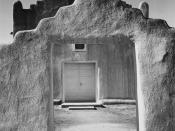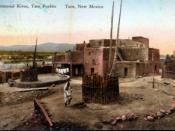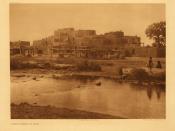The word Tao, while Native American in origin, is not necessarily a native term for the inhabitants of the small village in Northern New Mexico at the base of the Sangre de Cristo Mountains. Instead, it is the word other Rio Grande Pueblo Indians use to refer to their Pueblo dwelling friends. Roughly translated it means "to the north" or for the Taos Indians themselves; "to or toward the village" (Bodine 1977: 25). Later, during the Spanish conquest of New Mexico in the late 16th century, the Spaniards, in their habit of adding an "s" to nouns to form the plural, forever changed the name to what we know now as the Taos Pueblo Indians (Bodine 1977: 26). The Taos refer to themselves and their Pueblos as "lalaphin" meaning "red willow trees" or Red Willow People (Alpert 1983: 15). The Taos Indians speak Taos, a dialect of Tiwa. It is closely related to the three other Tiwa speaking Pueblo tribes in the area; The Picuris, The Isleta and The Sandia.
The Taos Pueblo Indians are most well known for their Pueblo housing structures which have been continuously inhabited for the last 1000 years (wikipedia.com/taos_pueblo). Their Pueblo (Latin in origin, meaning village) is a multi-storied series of apartments made of traditional adobe or adobe bricks. Adobe is made out of a crude mixture containing water, sand clay and straw. It is a rather hardy material known to keep cold weather out in the winter while also remaining cool in the summer (wikipedia.com/adobe).
The Taos Pueblo is thought to have been constructed sometime between 1000AD and 1400AD, however there is evidence of human settlement in the area dating back 3,000 years and some estimate that New Mexico was peopled by various Native Americans 10,000 years ago (Alpert 1983: 13-15). Additionally, hundreds of...


